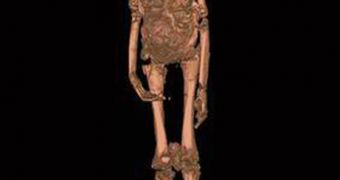The puzzle around the death of the Pharaoh Tutankhamun becomes more and more interesting. An upcoming TV documentary says the boy king could have died because of a fall from his chariot during a hunt.
2005 CT scans revealed a severe fracture in his left thighbone and theories about murder were replaced by the hypothesis of death from an infection.
"He had an accident when he was hunting in the desert. Falling from the chariot made this fracture in his left leg, and this really is in my opinion how he died." said Zahi Hawass, secretary general of the Supreme Council of Antiquities.
Hawass said this in "Secrets of the Boy King", the upcoming documentary which will be broadcast on October 30 on Britain's Channel Five.
The new hypothesis is also based on the investigation of some of the 5,000 artifacts encountered in the Tut's tomb, pointing he was an active, sporting young man, a fact that does not fit the classical image of the weak boy. At least two chariots found in the tomb display signs of frequent use and Tut could have been the driver.
Amongst the clothing found in Tut's tomb, there was a specially protective corset probably worn during high speed rides. Hundreds of arrowheads encountered in the tomb had signs of having been fired and retrieved.
Cornflowers and mayweed encountered in the floral arrangement at the Pharao's neck only bloom in the spring, around hunting season.
"The time for the mummification process would take about six weeks ? so you can then push that back and say he died something like the beginning of December or January, which was the middle of the winter hunting season," said Nigel Hepper, a botanist with Britain's Royal Botanic Gardens, Kew.
Tut has often been presented as a sickly and overprotected boy, but many issues point to the fact he was a robust and energetic teenager.
"There's been, to some extent, a perception in the past of Tut as the 'tragic' boy king. I think this has been done less in terms of looking at the evidence and what we know and more to sort of heighten the pathos of the wealth of the tomb and the fact that he wasn't terribly old when he died." said John Coleman Darnell, an Egyptologist at Yale University and author of "Tutankhamun's Armies".
"There is certainly plenty of evidence to suggest that he was not only an archer, but also a good charioteer. He came from the Tuthmosis family, who were well known earlier in the dynasty as military men and also huntsmen. Various artifacts also bear depictions of Tut in the act of hunting," said David P. Silverman, an Egyptologist at the University of Pennsylvania.
"Tut would have used a chariot often, as it was common for pharaohs of his era to present themselves as powerful warriors and take every opportunity to highlight their physical prowess. He would have used a chariot in ritual setting. He would have used it in ritualized shooting displays, riding the chariot, shooting his bows from the chariot. He might very possibly have used it on military campaigns. There would have been all these times when Tut would have been expected-and Tut would have expected himself-to get in the chariot," said Darnell.

 14 DAY TRIAL //
14 DAY TRIAL //